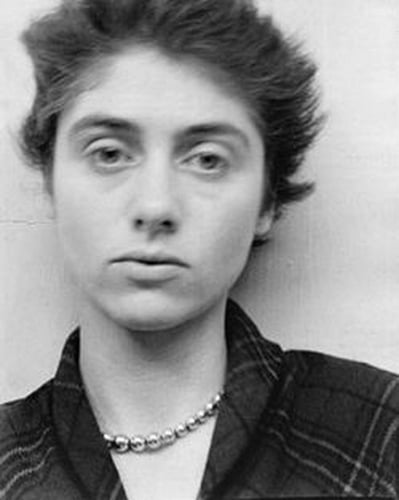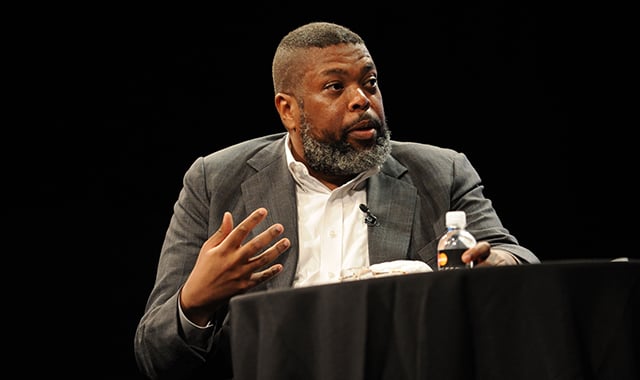People
Hilton Als Pays Homage to Diane Arbus and New York City With Gorgeous Love Letter
"You devoured the island of your birth."

"You devoured the island of your birth."

Cait Munro

If there’s one thing New Yorkers like to do, it’s reminisce about old New York and all of the icons who walked these hallowed sidewalks before them. To outsiders, this can read as a grating exercise in unearned nostalgia, but when a writer and cultural critic like Hilton Als sets his sights on capturing a historical slice of the Big Apple, even the wariest among us tend to sit up and listen.
Such was the case last night at the New Museum, where Als spoke to a brimming auditorium as part of the annual Stuart Regen Visionaries Series. Founded in honor of Stuart Regen, the founder of pioneering LA gallery Regen Projects and the late son of gallerist Barbara Gladstone, the speaker series has previously hosted Maya Lin, Darren Aronofsky, and Mad Men creator Matthew Weiner.
Als, who was born in New York, has written for the New Yorker since 1989 and published two acclaimed books, The Women and White Girls, took the opportunity to read his new essay “Diane Arbus in Manhattan.” It seems fitting that Als would choose to air this open love letter to and about Arbus, who died prematurely in 1971 at 48, in remembrance of Regen, who died in 1998 at 39.
Standing below a black-and-white photograph of a young Arbus and staring intensely at the crowd, Als described Regen as “a pure soul during a time defined by great sadness, AIDS, and avarice, and a fantastic audience if you were funny or crazy.” He described Arbus as “a funny, New York, Jewish something…always looking for something on an island filled with somethings.”
“Sometimes, when a person we admire or love leaves the scene prematurely, it can feel, at least to me, as if they’ve gotten up from their desk while composing a letter, one they have left permanently unfinished,” Als said at the beginning of his essay, reading in a measured tone that occasionally shifted as he became moved with emotion. “There are some who never make it back to that desk. They have their reasons, but we are awfully hard on the dead. But that’s just one way of not facing what they have been generous enough to leave us, including all those lovely half-finished letters.”

Hilton Als.
Photo: http://www1.cuny.edu.
Through an examination of her portfolio, letters, and life of running away from privilege toward the underbellies of Manhattan, Als used Arbus as a vessel through which to understand a certain moment of time in New York—much the way Arbus employed her camera to do the same. “I have this funny thing where I’m never afraid when I’m looking through the glass,” Als said quoting Arbus. “This person could be approaching me with a gun or something like that, and I’d have my eyes glued to the finder, and it was like I wasn’t really home. It just seemed terrific what was happening.”
Though Arbus began her career as a fashion photographer, it was her jarring, documentary-style images of people on the fringes of 1960s society—drag queens, dwarfs, children, minorities, people who hung out in Washington Square and Central Park—that continues to awaken something in viewers. Als recalled how Arbus’s photos were reviled when they were exhibited at the Museum of Modern Art in 1967.
“You devoured the island of your birth, and gave it back to itself re-imagined,” Als said to the room as though he were speaking to Arbus.
Like any good student of another individual with larger-than-life stature, Als was careful to reveal just enough of Arbus’s insecurities to convey her human side. “I’m not ghoulish am I?,” Arbus wrote in a 1960 letter to friend and fellow artist Marvin Israel after photographing a lady stretched out on the ground, talking to the cops with one shoe off and waiting for an ambulance. “I’d absolutely hate to have a bad conscience. I think of it as lewd. . .Is everyone ghoulish? I wouldn’t turn out to be a bad person if I looked, anyway. Would it make a difference if I were to look away?”
Als’s tone was ultimately one of both celebration and mourning—not just for Arbus or Regen or any of the other countless artists and creatives who have died too young—but for a different New York, one that was simultaneously simpler and much more complicated.
“For a number of years now, Diane, for months and days, I have been sitting with your pictures—black-and-white photographs that changed the world, and have changed me,” he said. “And your influence in those is so pervasive and conclusive, after looking at your work, one has to readjust one’s vision…Our present-day reality looks less real for you not having seen it first.”
Related stories:
Hilton Als to Debut New Essay on Diane Arbus as New Museum’s Visionary Speaker
What Are the 10 Best Works of Art in New York Museums? Let the Debate Begin
In a New Book, Alexander Nemerov Looks at his Aunt, Diane Arbus